Business Environment Report: Coca Cola and Macro Environment Analysis
VerifiedAdded on 2020/06/04
|14
|4544
|73
Report
AI Summary
This report provides a comprehensive analysis of Coca-Cola's business environment. It begins with an introduction defining the business environment and the chosen company. Task 1 delves into different types and purposes of organizations, differentiating between NGOs, NPOs, and for-profit entities. It also covers the public, private, and voluntary sectors, including their legal structures. The report examines the size and scope of various organizations, from micro to large scales, and discusses the objectives and scopes of each, including transnational corporations. The report also explores the relationships between different organizational functions like marketing, human resource management, and operations. The report then discusses the positive and negative impacts of the macro environment on business operations and includes PESTLE analysis to assess external factors. The report concludes with recommendations and a conclusion summarizing the findings and analysis. It emphasizes the interrelation between strengths, weaknesses, and external factors.
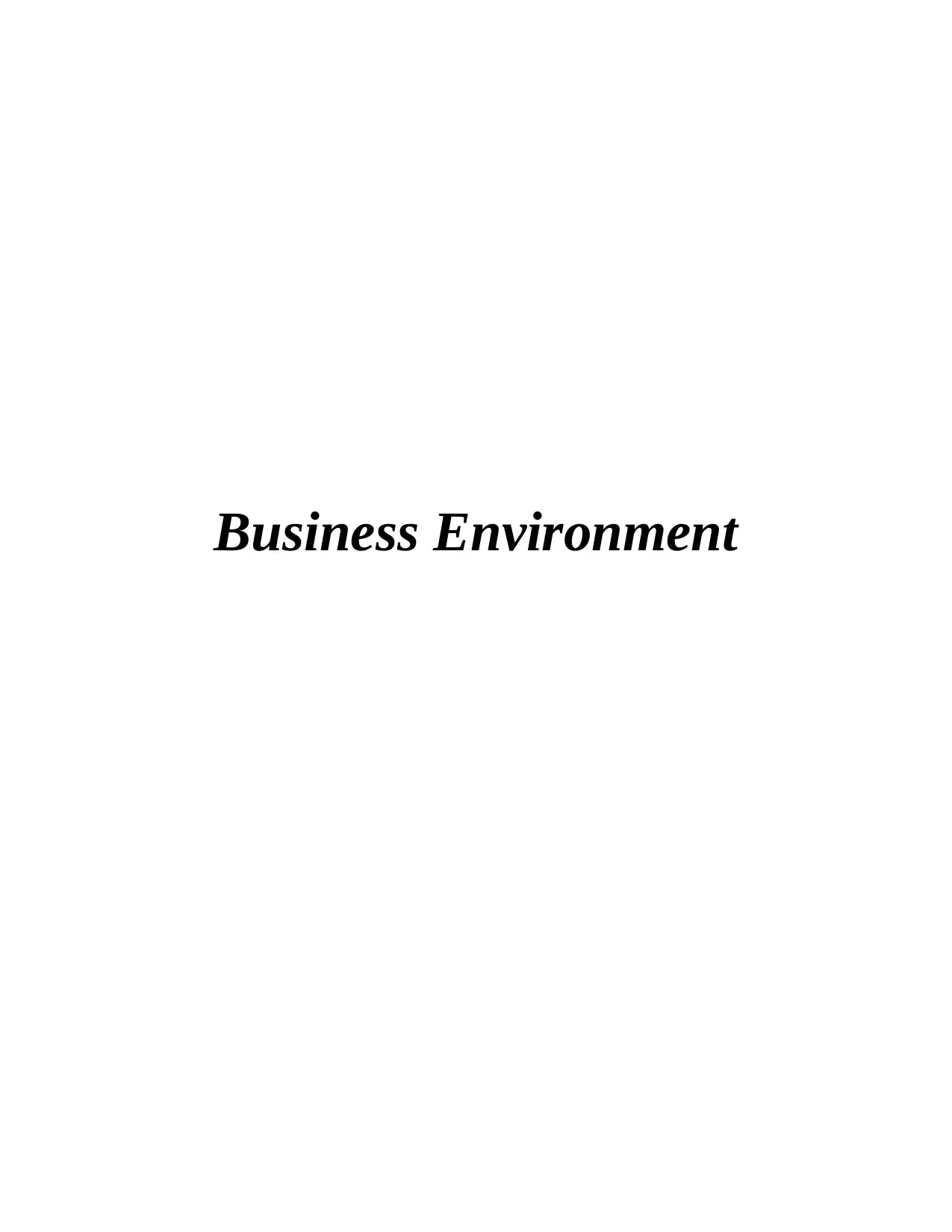
Business Environment
Paraphrase This Document
Need a fresh take? Get an instant paraphrase of this document with our AI Paraphraser
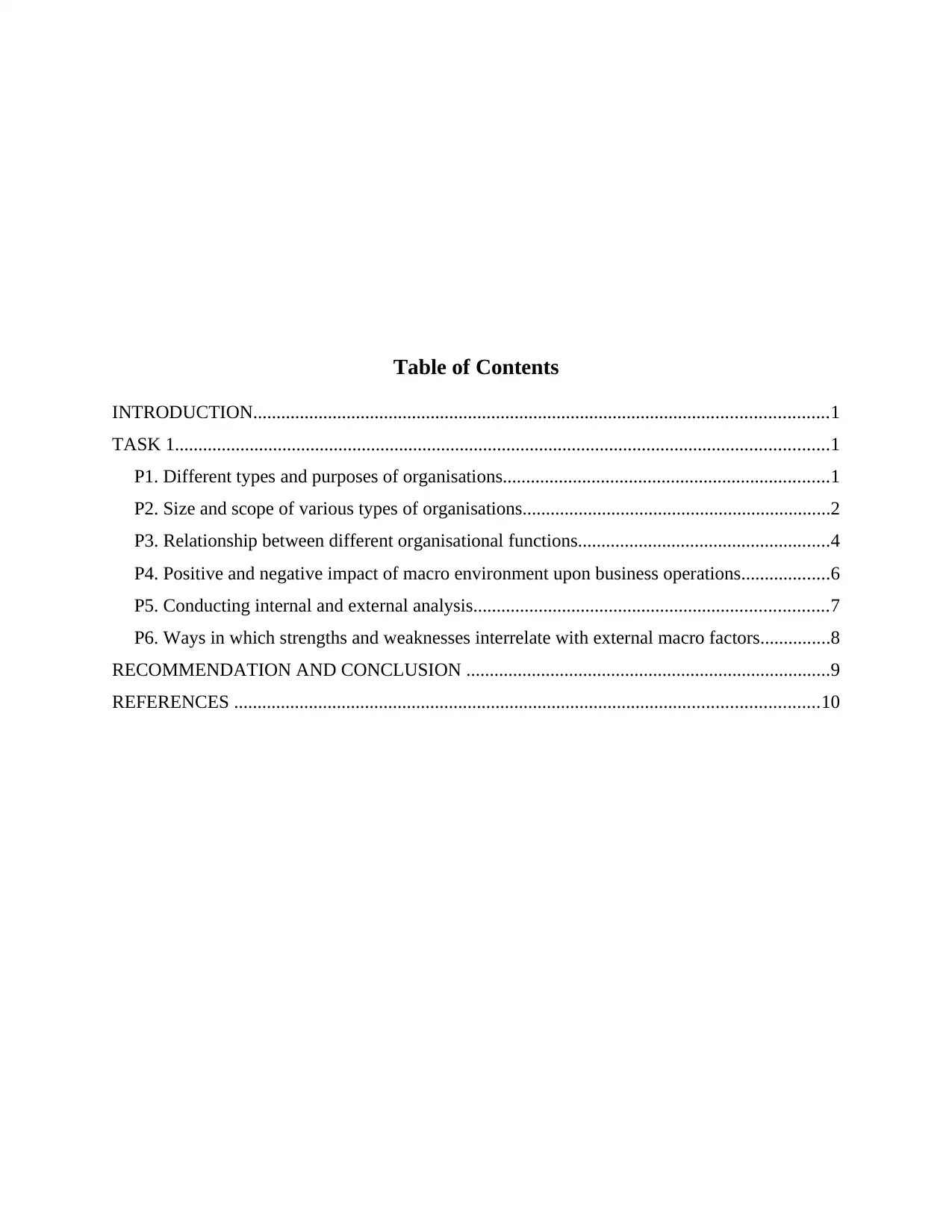
Table of Contents
INTRODUCTION...........................................................................................................................1
TASK 1............................................................................................................................................1
P1. Different types and purposes of organisations......................................................................1
P2. Size and scope of various types of organisations..................................................................2
P3. Relationship between different organisational functions......................................................4
P4. Positive and negative impact of macro environment upon business operations...................6
P5. Conducting internal and external analysis............................................................................7
P6. Ways in which strengths and weaknesses interrelate with external macro factors...............8
RECOMMENDATION AND CONCLUSION ..............................................................................9
REFERENCES .............................................................................................................................10
INTRODUCTION...........................................................................................................................1
TASK 1............................................................................................................................................1
P1. Different types and purposes of organisations......................................................................1
P2. Size and scope of various types of organisations..................................................................2
P3. Relationship between different organisational functions......................................................4
P4. Positive and negative impact of macro environment upon business operations...................6
P5. Conducting internal and external analysis............................................................................7
P6. Ways in which strengths and weaknesses interrelate with external macro factors...............8
RECOMMENDATION AND CONCLUSION ..............................................................................9
REFERENCES .............................................................................................................................10
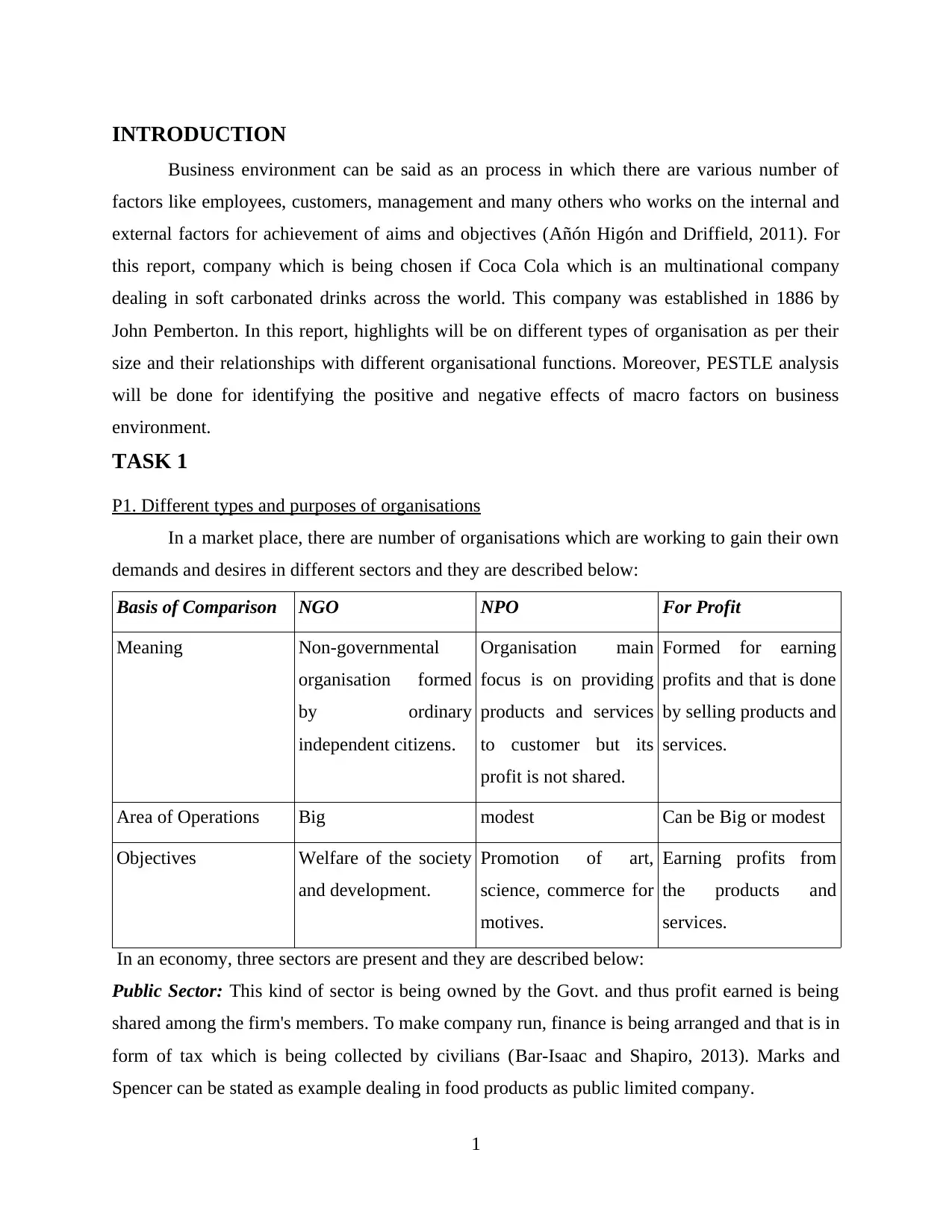
INTRODUCTION
Business environment can be said as an process in which there are various number of
factors like employees, customers, management and many others who works on the internal and
external factors for achievement of aims and objectives (Añón Higón and Driffield, 2011). For
this report, company which is being chosen if Coca Cola which is an multinational company
dealing in soft carbonated drinks across the world. This company was established in 1886 by
John Pemberton. In this report, highlights will be on different types of organisation as per their
size and their relationships with different organisational functions. Moreover, PESTLE analysis
will be done for identifying the positive and negative effects of macro factors on business
environment.
TASK 1
P1. Different types and purposes of organisations
In a market place, there are number of organisations which are working to gain their own
demands and desires in different sectors and they are described below:
Basis of Comparison NGO NPO For Profit
Meaning Non-governmental
organisation formed
by ordinary
independent citizens.
Organisation main
focus is on providing
products and services
to customer but its
profit is not shared.
Formed for earning
profits and that is done
by selling products and
services.
Area of Operations Big modest Can be Big or modest
Objectives Welfare of the society
and development.
Promotion of art,
science, commerce for
motives.
Earning profits from
the products and
services.
In an economy, three sectors are present and they are described below:
Public Sector: This kind of sector is being owned by the Govt. and thus profit earned is being
shared among the firm's members. To make company run, finance is being arranged and that is in
form of tax which is being collected by civilians (Bar-Isaac and Shapiro, 2013). Marks and
Spencer can be stated as example dealing in food products as public limited company.
1
Business environment can be said as an process in which there are various number of
factors like employees, customers, management and many others who works on the internal and
external factors for achievement of aims and objectives (Añón Higón and Driffield, 2011). For
this report, company which is being chosen if Coca Cola which is an multinational company
dealing in soft carbonated drinks across the world. This company was established in 1886 by
John Pemberton. In this report, highlights will be on different types of organisation as per their
size and their relationships with different organisational functions. Moreover, PESTLE analysis
will be done for identifying the positive and negative effects of macro factors on business
environment.
TASK 1
P1. Different types and purposes of organisations
In a market place, there are number of organisations which are working to gain their own
demands and desires in different sectors and they are described below:
Basis of Comparison NGO NPO For Profit
Meaning Non-governmental
organisation formed
by ordinary
independent citizens.
Organisation main
focus is on providing
products and services
to customer but its
profit is not shared.
Formed for earning
profits and that is done
by selling products and
services.
Area of Operations Big modest Can be Big or modest
Objectives Welfare of the society
and development.
Promotion of art,
science, commerce for
motives.
Earning profits from
the products and
services.
In an economy, three sectors are present and they are described below:
Public Sector: This kind of sector is being owned by the Govt. and thus profit earned is being
shared among the firm's members. To make company run, finance is being arranged and that is in
form of tax which is being collected by civilians (Bar-Isaac and Shapiro, 2013). Marks and
Spencer can be stated as example dealing in food products as public limited company.
1
⊘ This is a preview!⊘
Do you want full access?
Subscribe today to unlock all pages.

Trusted by 1+ million students worldwide
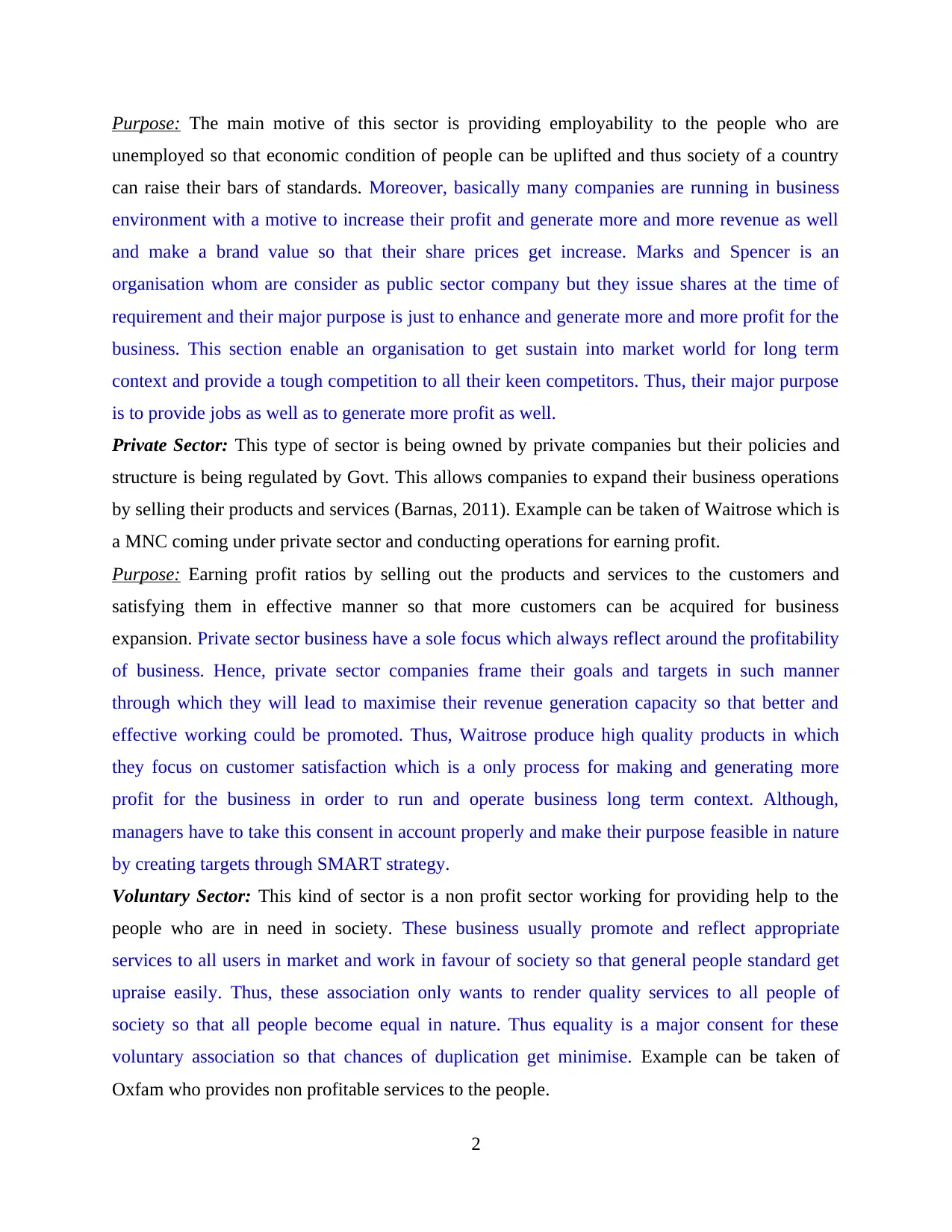
Purpose: The main motive of this sector is providing employability to the people who are
unemployed so that economic condition of people can be uplifted and thus society of a country
can raise their bars of standards. Moreover, basically many companies are running in business
environment with a motive to increase their profit and generate more and more revenue as well
and make a brand value so that their share prices get increase. Marks and Spencer is an
organisation whom are consider as public sector company but they issue shares at the time of
requirement and their major purpose is just to enhance and generate more and more profit for the
business. This section enable an organisation to get sustain into market world for long term
context and provide a tough competition to all their keen competitors. Thus, their major purpose
is to provide jobs as well as to generate more profit as well.
Private Sector: This type of sector is being owned by private companies but their policies and
structure is being regulated by Govt. This allows companies to expand their business operations
by selling their products and services (Barnas, 2011). Example can be taken of Waitrose which is
a MNC coming under private sector and conducting operations for earning profit.
Purpose: Earning profit ratios by selling out the products and services to the customers and
satisfying them in effective manner so that more customers can be acquired for business
expansion. Private sector business have a sole focus which always reflect around the profitability
of business. Hence, private sector companies frame their goals and targets in such manner
through which they will lead to maximise their revenue generation capacity so that better and
effective working could be promoted. Thus, Waitrose produce high quality products in which
they focus on customer satisfaction which is a only process for making and generating more
profit for the business in order to run and operate business long term context. Although,
managers have to take this consent in account properly and make their purpose feasible in nature
by creating targets through SMART strategy.
Voluntary Sector: This kind of sector is a non profit sector working for providing help to the
people who are in need in society. These business usually promote and reflect appropriate
services to all users in market and work in favour of society so that general people standard get
upraise easily. Thus, these association only wants to render quality services to all people of
society so that all people become equal in nature. Thus equality is a major consent for these
voluntary association so that chances of duplication get minimise. Example can be taken of
Oxfam who provides non profitable services to the people.
2
unemployed so that economic condition of people can be uplifted and thus society of a country
can raise their bars of standards. Moreover, basically many companies are running in business
environment with a motive to increase their profit and generate more and more revenue as well
and make a brand value so that their share prices get increase. Marks and Spencer is an
organisation whom are consider as public sector company but they issue shares at the time of
requirement and their major purpose is just to enhance and generate more and more profit for the
business. This section enable an organisation to get sustain into market world for long term
context and provide a tough competition to all their keen competitors. Thus, their major purpose
is to provide jobs as well as to generate more profit as well.
Private Sector: This type of sector is being owned by private companies but their policies and
structure is being regulated by Govt. This allows companies to expand their business operations
by selling their products and services (Barnas, 2011). Example can be taken of Waitrose which is
a MNC coming under private sector and conducting operations for earning profit.
Purpose: Earning profit ratios by selling out the products and services to the customers and
satisfying them in effective manner so that more customers can be acquired for business
expansion. Private sector business have a sole focus which always reflect around the profitability
of business. Hence, private sector companies frame their goals and targets in such manner
through which they will lead to maximise their revenue generation capacity so that better and
effective working could be promoted. Thus, Waitrose produce high quality products in which
they focus on customer satisfaction which is a only process for making and generating more
profit for the business in order to run and operate business long term context. Although,
managers have to take this consent in account properly and make their purpose feasible in nature
by creating targets through SMART strategy.
Voluntary Sector: This kind of sector is a non profit sector working for providing help to the
people who are in need in society. These business usually promote and reflect appropriate
services to all users in market and work in favour of society so that general people standard get
upraise easily. Thus, these association only wants to render quality services to all people of
society so that all people become equal in nature. Thus equality is a major consent for these
voluntary association so that chances of duplication get minimise. Example can be taken of
Oxfam who provides non profitable services to the people.
2
Paraphrase This Document
Need a fresh take? Get an instant paraphrase of this document with our AI Paraphraser
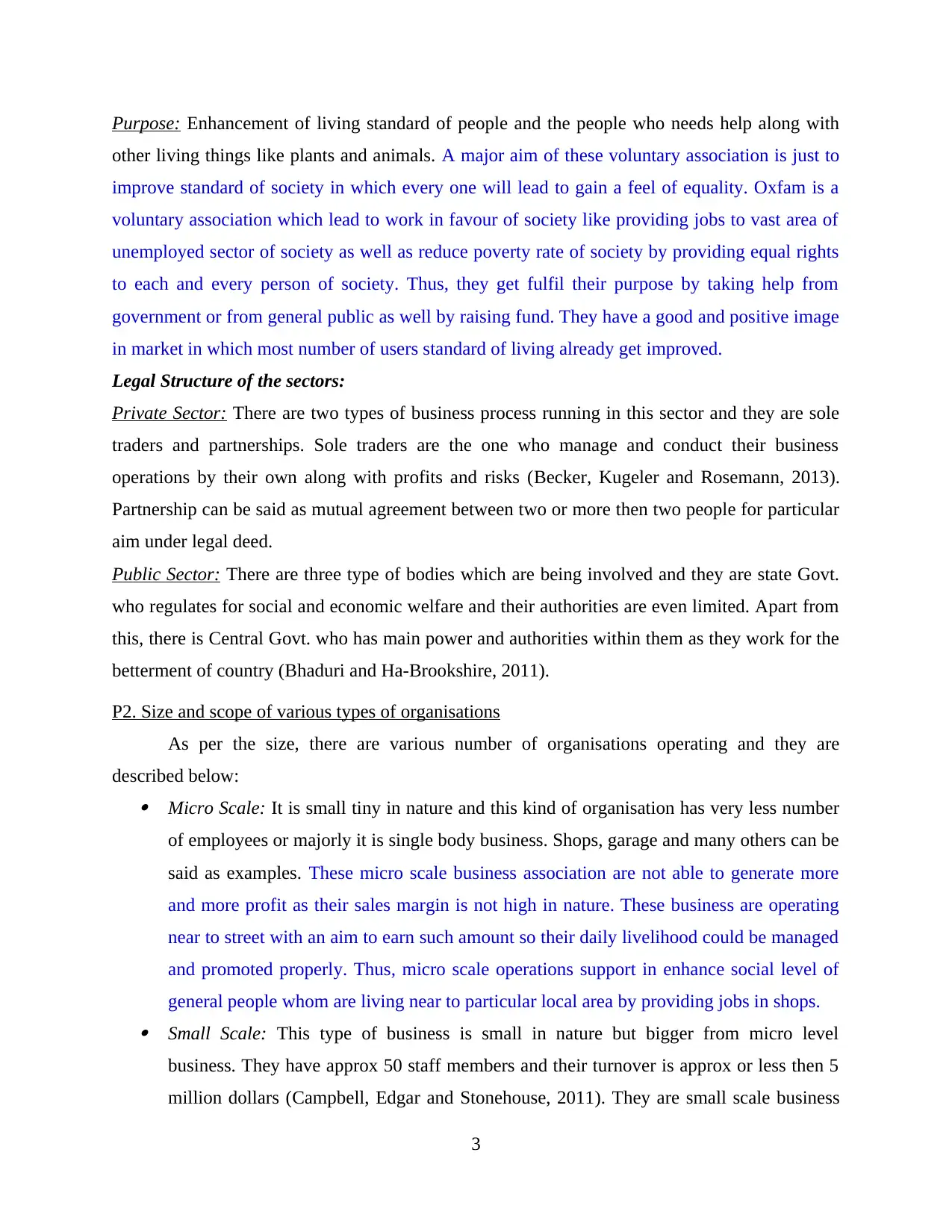
Purpose: Enhancement of living standard of people and the people who needs help along with
other living things like plants and animals. A major aim of these voluntary association is just to
improve standard of society in which every one will lead to gain a feel of equality. Oxfam is a
voluntary association which lead to work in favour of society like providing jobs to vast area of
unemployed sector of society as well as reduce poverty rate of society by providing equal rights
to each and every person of society. Thus, they get fulfil their purpose by taking help from
government or from general public as well by raising fund. They have a good and positive image
in market in which most number of users standard of living already get improved.
Legal Structure of the sectors:
Private Sector: There are two types of business process running in this sector and they are sole
traders and partnerships. Sole traders are the one who manage and conduct their business
operations by their own along with profits and risks (Becker, Kugeler and Rosemann, 2013).
Partnership can be said as mutual agreement between two or more then two people for particular
aim under legal deed.
Public Sector: There are three type of bodies which are being involved and they are state Govt.
who regulates for social and economic welfare and their authorities are even limited. Apart from
this, there is Central Govt. who has main power and authorities within them as they work for the
betterment of country (Bhaduri and Ha-Brookshire, 2011).
P2. Size and scope of various types of organisations
As per the size, there are various number of organisations operating and they are
described below: Micro Scale: It is small tiny in nature and this kind of organisation has very less number
of employees or majorly it is single body business. Shops, garage and many others can be
said as examples. These micro scale business association are not able to generate more
and more profit as their sales margin is not high in nature. These business are operating
near to street with an aim to earn such amount so their daily livelihood could be managed
and promoted properly. Thus, micro scale operations support in enhance social level of
general people whom are living near to particular local area by providing jobs in shops. Small Scale: This type of business is small in nature but bigger from micro level
business. They have approx 50 staff members and their turnover is approx or less then 5
million dollars (Campbell, Edgar and Stonehouse, 2011). They are small scale business
3
other living things like plants and animals. A major aim of these voluntary association is just to
improve standard of society in which every one will lead to gain a feel of equality. Oxfam is a
voluntary association which lead to work in favour of society like providing jobs to vast area of
unemployed sector of society as well as reduce poverty rate of society by providing equal rights
to each and every person of society. Thus, they get fulfil their purpose by taking help from
government or from general public as well by raising fund. They have a good and positive image
in market in which most number of users standard of living already get improved.
Legal Structure of the sectors:
Private Sector: There are two types of business process running in this sector and they are sole
traders and partnerships. Sole traders are the one who manage and conduct their business
operations by their own along with profits and risks (Becker, Kugeler and Rosemann, 2013).
Partnership can be said as mutual agreement between two or more then two people for particular
aim under legal deed.
Public Sector: There are three type of bodies which are being involved and they are state Govt.
who regulates for social and economic welfare and their authorities are even limited. Apart from
this, there is Central Govt. who has main power and authorities within them as they work for the
betterment of country (Bhaduri and Ha-Brookshire, 2011).
P2. Size and scope of various types of organisations
As per the size, there are various number of organisations operating and they are
described below: Micro Scale: It is small tiny in nature and this kind of organisation has very less number
of employees or majorly it is single body business. Shops, garage and many others can be
said as examples. These micro scale business association are not able to generate more
and more profit as their sales margin is not high in nature. These business are operating
near to street with an aim to earn such amount so their daily livelihood could be managed
and promoted properly. Thus, micro scale operations support in enhance social level of
general people whom are living near to particular local area by providing jobs in shops. Small Scale: This type of business is small in nature but bigger from micro level
business. They have approx 50 staff members and their turnover is approx or less then 5
million dollars (Campbell, Edgar and Stonehouse, 2011). They are small scale business
3
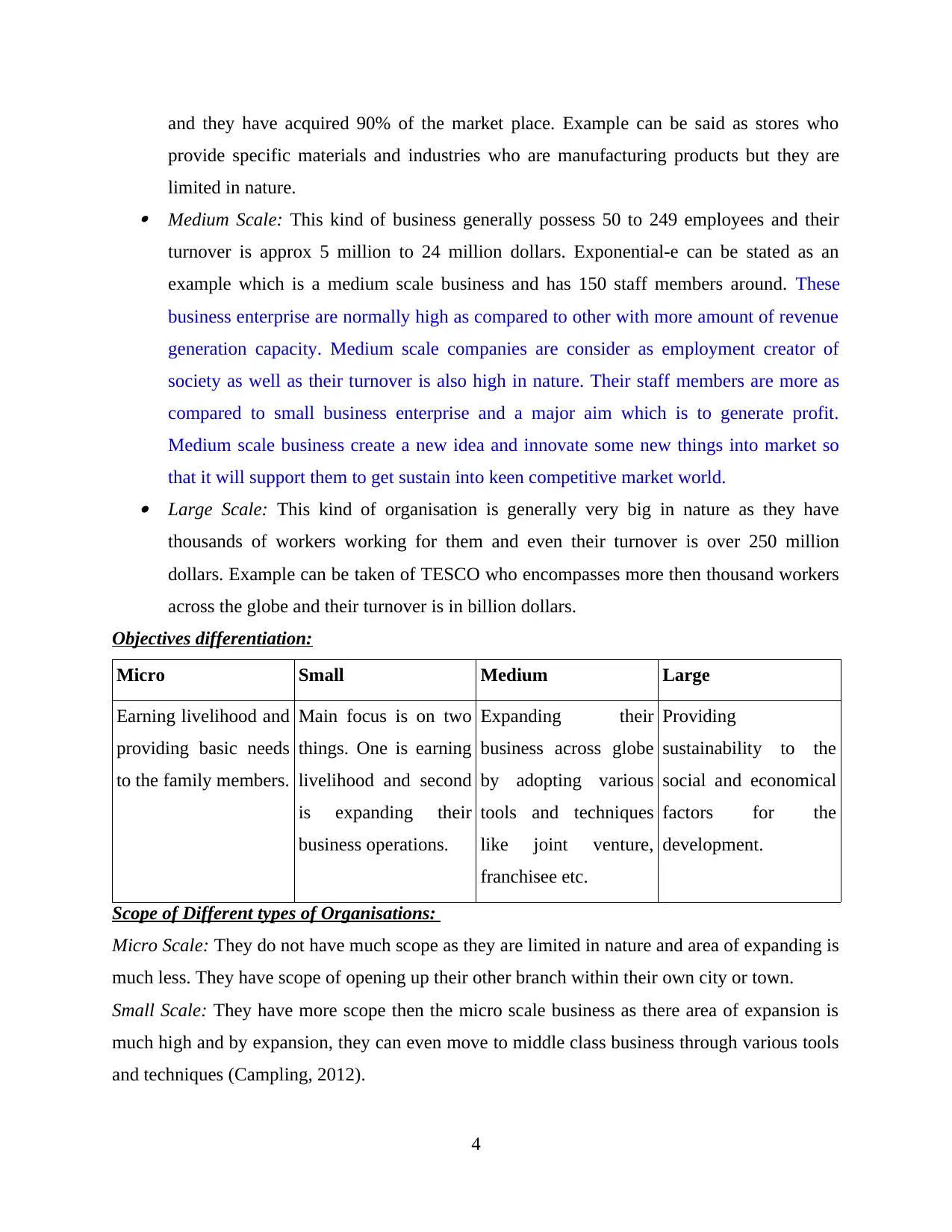
and they have acquired 90% of the market place. Example can be said as stores who
provide specific materials and industries who are manufacturing products but they are
limited in nature. Medium Scale: This kind of business generally possess 50 to 249 employees and their
turnover is approx 5 million to 24 million dollars. Exponential-e can be stated as an
example which is a medium scale business and has 150 staff members around. These
business enterprise are normally high as compared to other with more amount of revenue
generation capacity. Medium scale companies are consider as employment creator of
society as well as their turnover is also high in nature. Their staff members are more as
compared to small business enterprise and a major aim which is to generate profit.
Medium scale business create a new idea and innovate some new things into market so
that it will support them to get sustain into keen competitive market world. Large Scale: This kind of organisation is generally very big in nature as they have
thousands of workers working for them and even their turnover is over 250 million
dollars. Example can be taken of TESCO who encompasses more then thousand workers
across the globe and their turnover is in billion dollars.
Objectives differentiation:
Micro Small Medium Large
Earning livelihood and
providing basic needs
to the family members.
Main focus is on two
things. One is earning
livelihood and second
is expanding their
business operations.
Expanding their
business across globe
by adopting various
tools and techniques
like joint venture,
franchisee etc.
Providing
sustainability to the
social and economical
factors for the
development.
Scope of Different types of Organisations:
Micro Scale: They do not have much scope as they are limited in nature and area of expanding is
much less. They have scope of opening up their other branch within their own city or town.
Small Scale: They have more scope then the micro scale business as there area of expansion is
much high and by expansion, they can even move to middle class business through various tools
and techniques (Campling, 2012).
4
provide specific materials and industries who are manufacturing products but they are
limited in nature. Medium Scale: This kind of business generally possess 50 to 249 employees and their
turnover is approx 5 million to 24 million dollars. Exponential-e can be stated as an
example which is a medium scale business and has 150 staff members around. These
business enterprise are normally high as compared to other with more amount of revenue
generation capacity. Medium scale companies are consider as employment creator of
society as well as their turnover is also high in nature. Their staff members are more as
compared to small business enterprise and a major aim which is to generate profit.
Medium scale business create a new idea and innovate some new things into market so
that it will support them to get sustain into keen competitive market world. Large Scale: This kind of organisation is generally very big in nature as they have
thousands of workers working for them and even their turnover is over 250 million
dollars. Example can be taken of TESCO who encompasses more then thousand workers
across the globe and their turnover is in billion dollars.
Objectives differentiation:
Micro Small Medium Large
Earning livelihood and
providing basic needs
to the family members.
Main focus is on two
things. One is earning
livelihood and second
is expanding their
business operations.
Expanding their
business across globe
by adopting various
tools and techniques
like joint venture,
franchisee etc.
Providing
sustainability to the
social and economical
factors for the
development.
Scope of Different types of Organisations:
Micro Scale: They do not have much scope as they are limited in nature and area of expanding is
much less. They have scope of opening up their other branch within their own city or town.
Small Scale: They have more scope then the micro scale business as there area of expansion is
much high and by expansion, they can even move to middle class business through various tools
and techniques (Campling, 2012).
4
⊘ This is a preview!⊘
Do you want full access?
Subscribe today to unlock all pages.

Trusted by 1+ million students worldwide
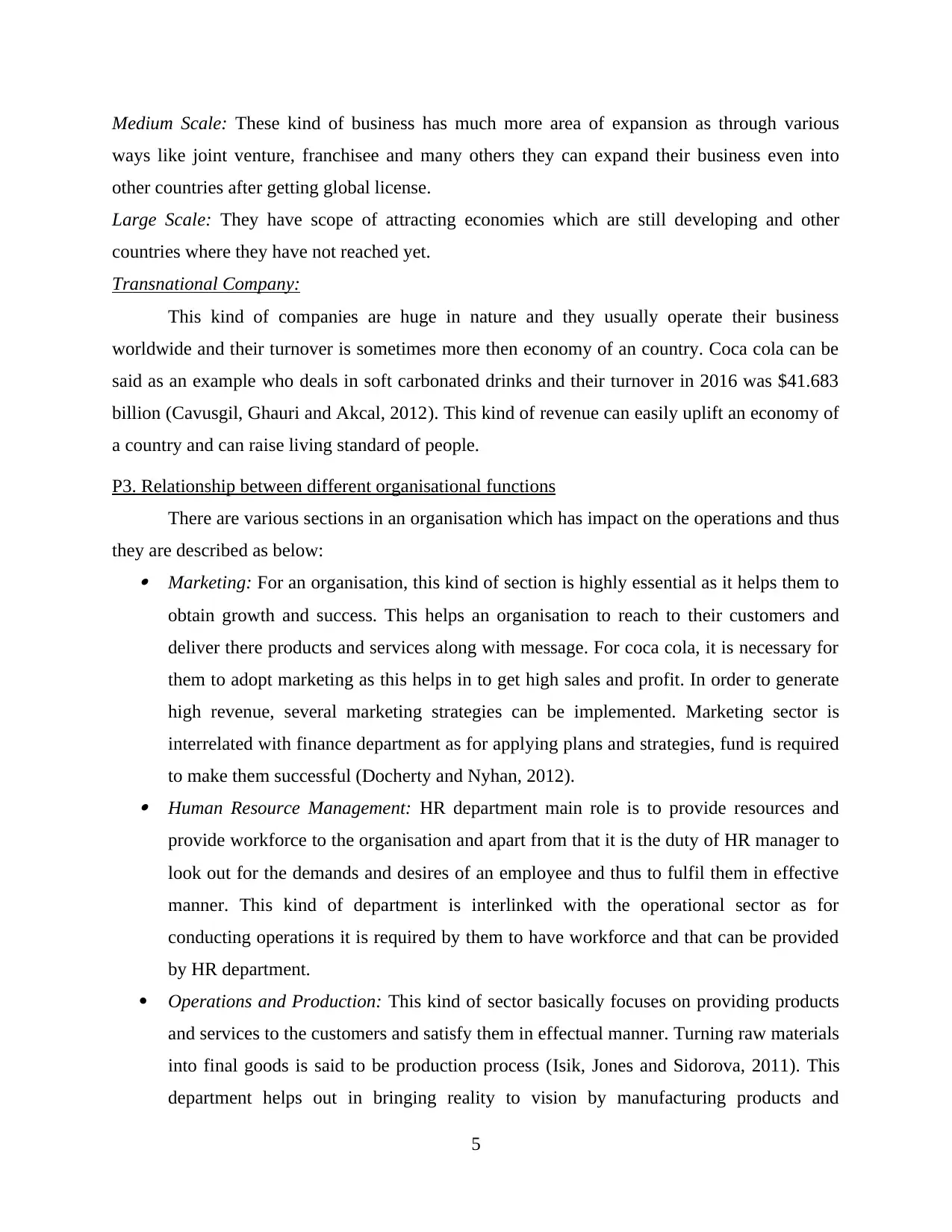
Medium Scale: These kind of business has much more area of expansion as through various
ways like joint venture, franchisee and many others they can expand their business even into
other countries after getting global license.
Large Scale: They have scope of attracting economies which are still developing and other
countries where they have not reached yet.
Transnational Company:
This kind of companies are huge in nature and they usually operate their business
worldwide and their turnover is sometimes more then economy of an country. Coca cola can be
said as an example who deals in soft carbonated drinks and their turnover in 2016 was $41.683
billion (Cavusgil, Ghauri and Akcal, 2012). This kind of revenue can easily uplift an economy of
a country and can raise living standard of people.
P3. Relationship between different organisational functions
There are various sections in an organisation which has impact on the operations and thus
they are described as below: Marketing: For an organisation, this kind of section is highly essential as it helps them to
obtain growth and success. This helps an organisation to reach to their customers and
deliver there products and services along with message. For coca cola, it is necessary for
them to adopt marketing as this helps in to get high sales and profit. In order to generate
high revenue, several marketing strategies can be implemented. Marketing sector is
interrelated with finance department as for applying plans and strategies, fund is required
to make them successful (Docherty and Nyhan, 2012). Human Resource Management: HR department main role is to provide resources and
provide workforce to the organisation and apart from that it is the duty of HR manager to
look out for the demands and desires of an employee and thus to fulfil them in effective
manner. This kind of department is interlinked with the operational sector as for
conducting operations it is required by them to have workforce and that can be provided
by HR department.
Operations and Production: This kind of sector basically focuses on providing products
and services to the customers and satisfy them in effectual manner. Turning raw materials
into final goods is said to be production process (Isik, Jones and Sidorova, 2011). This
department helps out in bringing reality to vision by manufacturing products and
5
ways like joint venture, franchisee and many others they can expand their business even into
other countries after getting global license.
Large Scale: They have scope of attracting economies which are still developing and other
countries where they have not reached yet.
Transnational Company:
This kind of companies are huge in nature and they usually operate their business
worldwide and their turnover is sometimes more then economy of an country. Coca cola can be
said as an example who deals in soft carbonated drinks and their turnover in 2016 was $41.683
billion (Cavusgil, Ghauri and Akcal, 2012). This kind of revenue can easily uplift an economy of
a country and can raise living standard of people.
P3. Relationship between different organisational functions
There are various sections in an organisation which has impact on the operations and thus
they are described as below: Marketing: For an organisation, this kind of section is highly essential as it helps them to
obtain growth and success. This helps an organisation to reach to their customers and
deliver there products and services along with message. For coca cola, it is necessary for
them to adopt marketing as this helps in to get high sales and profit. In order to generate
high revenue, several marketing strategies can be implemented. Marketing sector is
interrelated with finance department as for applying plans and strategies, fund is required
to make them successful (Docherty and Nyhan, 2012). Human Resource Management: HR department main role is to provide resources and
provide workforce to the organisation and apart from that it is the duty of HR manager to
look out for the demands and desires of an employee and thus to fulfil them in effective
manner. This kind of department is interlinked with the operational sector as for
conducting operations it is required by them to have workforce and that can be provided
by HR department.
Operations and Production: This kind of sector basically focuses on providing products
and services to the customers and satisfy them in effectual manner. Turning raw materials
into final goods is said to be production process (Isik, Jones and Sidorova, 2011). This
department helps out in bringing reality to vision by manufacturing products and
5
Paraphrase This Document
Need a fresh take? Get an instant paraphrase of this document with our AI Paraphraser
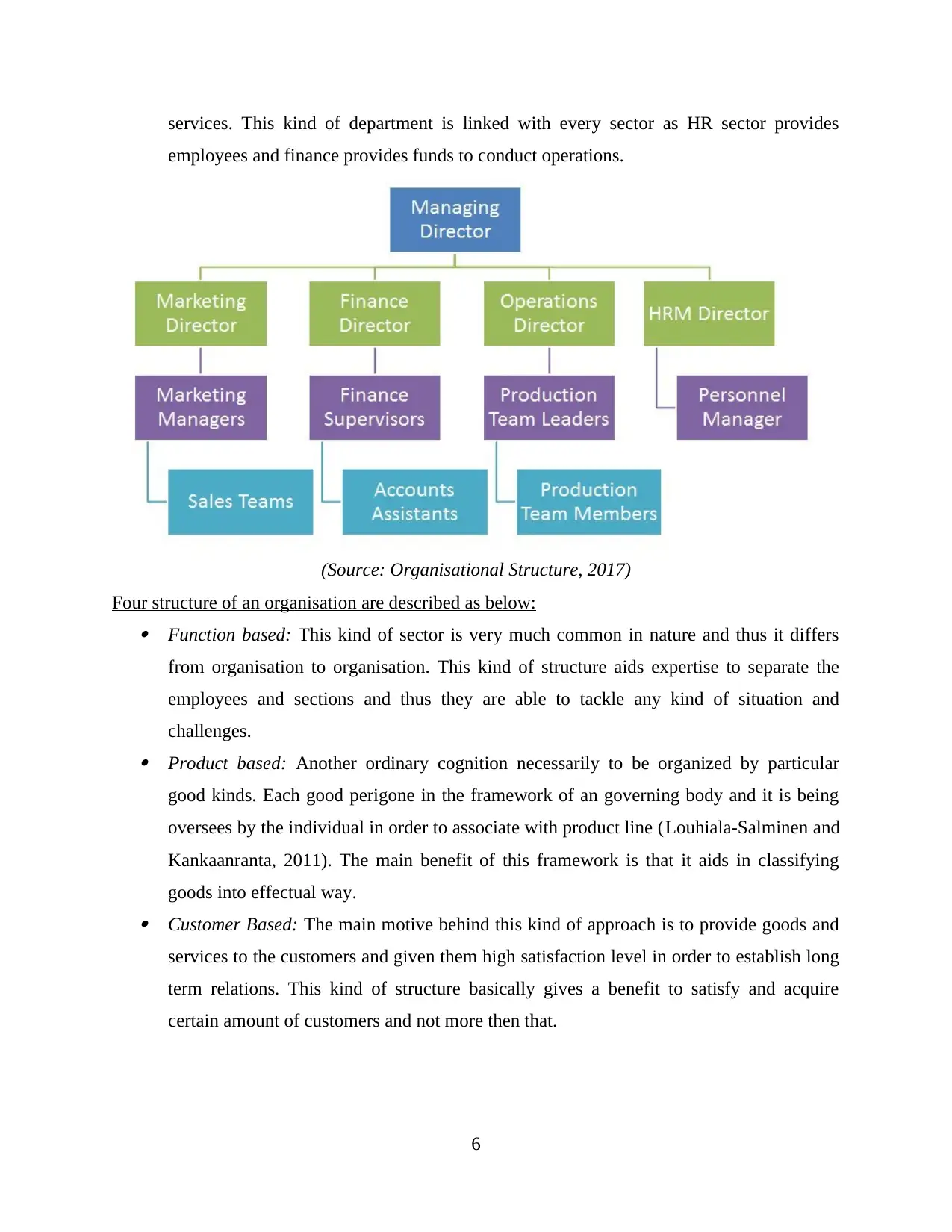
services. This kind of department is linked with every sector as HR sector provides
employees and finance provides funds to conduct operations.
(Source: Organisational Structure, 2017)
Four structure of an organisation are described as below: Function based: This kind of sector is very much common in nature and thus it differs
from organisation to organisation. This kind of structure aids expertise to separate the
employees and sections and thus they are able to tackle any kind of situation and
challenges. Product based: Another ordinary cognition necessarily to be organized by particular
good kinds. Each good perigone in the framework of an governing body and it is being
oversees by the individual in order to associate with product line (Louhiala-Salminen and
Kankaanranta, 2011). The main benefit of this framework is that it aids in classifying
goods into effectual way. Customer Based: The main motive behind this kind of approach is to provide goods and
services to the customers and given them high satisfaction level in order to establish long
term relations. This kind of structure basically gives a benefit to satisfy and acquire
certain amount of customers and not more then that.
6
employees and finance provides funds to conduct operations.
(Source: Organisational Structure, 2017)
Four structure of an organisation are described as below: Function based: This kind of sector is very much common in nature and thus it differs
from organisation to organisation. This kind of structure aids expertise to separate the
employees and sections and thus they are able to tackle any kind of situation and
challenges. Product based: Another ordinary cognition necessarily to be organized by particular
good kinds. Each good perigone in the framework of an governing body and it is being
oversees by the individual in order to associate with product line (Louhiala-Salminen and
Kankaanranta, 2011). The main benefit of this framework is that it aids in classifying
goods into effectual way. Customer Based: The main motive behind this kind of approach is to provide goods and
services to the customers and given them high satisfaction level in order to establish long
term relations. This kind of structure basically gives a benefit to satisfy and acquire
certain amount of customers and not more then that.
6
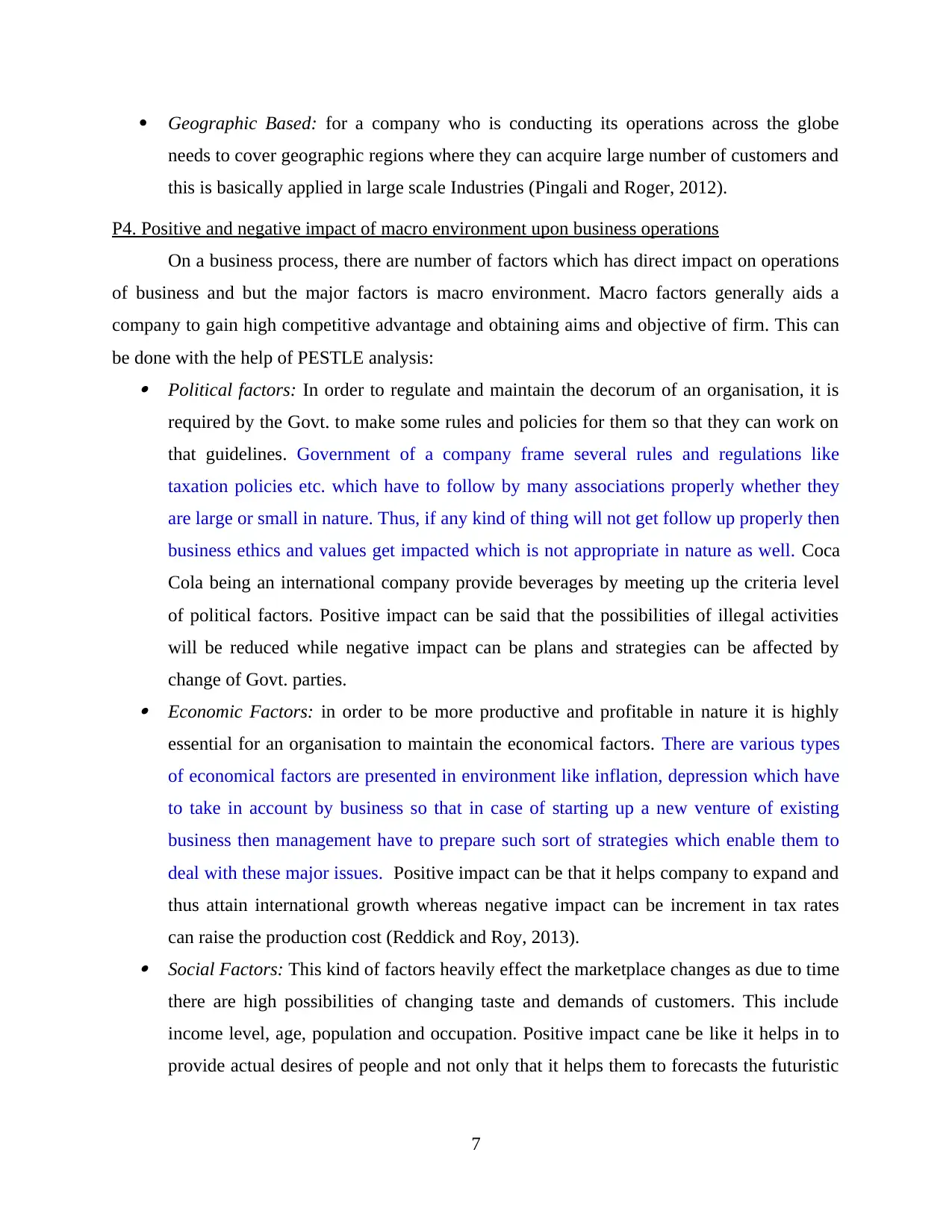
Geographic Based: for a company who is conducting its operations across the globe
needs to cover geographic regions where they can acquire large number of customers and
this is basically applied in large scale Industries (Pingali and Roger, 2012).
P4. Positive and negative impact of macro environment upon business operations
On a business process, there are number of factors which has direct impact on operations
of business and but the major factors is macro environment. Macro factors generally aids a
company to gain high competitive advantage and obtaining aims and objective of firm. This can
be done with the help of PESTLE analysis: Political factors: In order to regulate and maintain the decorum of an organisation, it is
required by the Govt. to make some rules and policies for them so that they can work on
that guidelines. Government of a company frame several rules and regulations like
taxation policies etc. which have to follow by many associations properly whether they
are large or small in nature. Thus, if any kind of thing will not get follow up properly then
business ethics and values get impacted which is not appropriate in nature as well. Coca
Cola being an international company provide beverages by meeting up the criteria level
of political factors. Positive impact can be said that the possibilities of illegal activities
will be reduced while negative impact can be plans and strategies can be affected by
change of Govt. parties. Economic Factors: in order to be more productive and profitable in nature it is highly
essential for an organisation to maintain the economical factors. There are various types
of economical factors are presented in environment like inflation, depression which have
to take in account by business so that in case of starting up a new venture of existing
business then management have to prepare such sort of strategies which enable them to
deal with these major issues. Positive impact can be that it helps company to expand and
thus attain international growth whereas negative impact can be increment in tax rates
can raise the production cost (Reddick and Roy, 2013). Social Factors: This kind of factors heavily effect the marketplace changes as due to time
there are high possibilities of changing taste and demands of customers. This include
income level, age, population and occupation. Positive impact cane be like it helps in to
provide actual desires of people and not only that it helps them to forecasts the futuristic
7
needs to cover geographic regions where they can acquire large number of customers and
this is basically applied in large scale Industries (Pingali and Roger, 2012).
P4. Positive and negative impact of macro environment upon business operations
On a business process, there are number of factors which has direct impact on operations
of business and but the major factors is macro environment. Macro factors generally aids a
company to gain high competitive advantage and obtaining aims and objective of firm. This can
be done with the help of PESTLE analysis: Political factors: In order to regulate and maintain the decorum of an organisation, it is
required by the Govt. to make some rules and policies for them so that they can work on
that guidelines. Government of a company frame several rules and regulations like
taxation policies etc. which have to follow by many associations properly whether they
are large or small in nature. Thus, if any kind of thing will not get follow up properly then
business ethics and values get impacted which is not appropriate in nature as well. Coca
Cola being an international company provide beverages by meeting up the criteria level
of political factors. Positive impact can be said that the possibilities of illegal activities
will be reduced while negative impact can be plans and strategies can be affected by
change of Govt. parties. Economic Factors: in order to be more productive and profitable in nature it is highly
essential for an organisation to maintain the economical factors. There are various types
of economical factors are presented in environment like inflation, depression which have
to take in account by business so that in case of starting up a new venture of existing
business then management have to prepare such sort of strategies which enable them to
deal with these major issues. Positive impact can be that it helps company to expand and
thus attain international growth whereas negative impact can be increment in tax rates
can raise the production cost (Reddick and Roy, 2013). Social Factors: This kind of factors heavily effect the marketplace changes as due to time
there are high possibilities of changing taste and demands of customers. This include
income level, age, population and occupation. Positive impact cane be like it helps in to
provide actual desires of people and not only that it helps them to forecasts the futuristic
7
⊘ This is a preview!⊘
Do you want full access?
Subscribe today to unlock all pages.

Trusted by 1+ million students worldwide
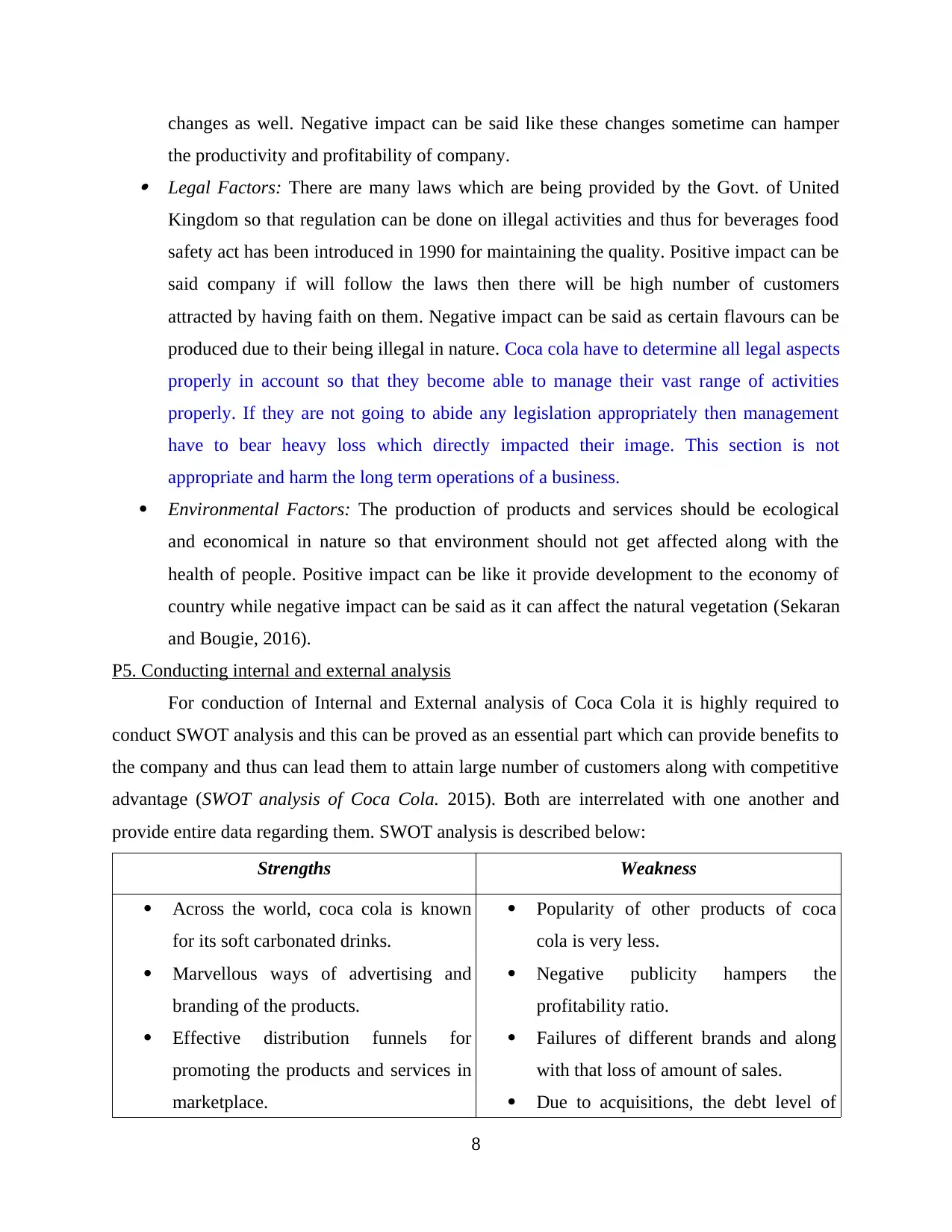
changes as well. Negative impact can be said like these changes sometime can hamper
the productivity and profitability of company. Legal Factors: There are many laws which are being provided by the Govt. of United
Kingdom so that regulation can be done on illegal activities and thus for beverages food
safety act has been introduced in 1990 for maintaining the quality. Positive impact can be
said company if will follow the laws then there will be high number of customers
attracted by having faith on them. Negative impact can be said as certain flavours can be
produced due to their being illegal in nature. Coca cola have to determine all legal aspects
properly in account so that they become able to manage their vast range of activities
properly. If they are not going to abide any legislation appropriately then management
have to bear heavy loss which directly impacted their image. This section is not
appropriate and harm the long term operations of a business.
Environmental Factors: The production of products and services should be ecological
and economical in nature so that environment should not get affected along with the
health of people. Positive impact can be like it provide development to the economy of
country while negative impact can be said as it can affect the natural vegetation (Sekaran
and Bougie, 2016).
P5. Conducting internal and external analysis
For conduction of Internal and External analysis of Coca Cola it is highly required to
conduct SWOT analysis and this can be proved as an essential part which can provide benefits to
the company and thus can lead them to attain large number of customers along with competitive
advantage (SWOT analysis of Coca Cola. 2015). Both are interrelated with one another and
provide entire data regarding them. SWOT analysis is described below:
Strengths Weakness
Across the world, coca cola is known
for its soft carbonated drinks.
Marvellous ways of advertising and
branding of the products.
Effective distribution funnels for
promoting the products and services in
marketplace.
Popularity of other products of coca
cola is very less.
Negative publicity hampers the
profitability ratio.
Failures of different brands and along
with that loss of amount of sales.
Due to acquisitions, the debt level of
8
the productivity and profitability of company. Legal Factors: There are many laws which are being provided by the Govt. of United
Kingdom so that regulation can be done on illegal activities and thus for beverages food
safety act has been introduced in 1990 for maintaining the quality. Positive impact can be
said company if will follow the laws then there will be high number of customers
attracted by having faith on them. Negative impact can be said as certain flavours can be
produced due to their being illegal in nature. Coca cola have to determine all legal aspects
properly in account so that they become able to manage their vast range of activities
properly. If they are not going to abide any legislation appropriately then management
have to bear heavy loss which directly impacted their image. This section is not
appropriate and harm the long term operations of a business.
Environmental Factors: The production of products and services should be ecological
and economical in nature so that environment should not get affected along with the
health of people. Positive impact can be like it provide development to the economy of
country while negative impact can be said as it can affect the natural vegetation (Sekaran
and Bougie, 2016).
P5. Conducting internal and external analysis
For conduction of Internal and External analysis of Coca Cola it is highly required to
conduct SWOT analysis and this can be proved as an essential part which can provide benefits to
the company and thus can lead them to attain large number of customers along with competitive
advantage (SWOT analysis of Coca Cola. 2015). Both are interrelated with one another and
provide entire data regarding them. SWOT analysis is described below:
Strengths Weakness
Across the world, coca cola is known
for its soft carbonated drinks.
Marvellous ways of advertising and
branding of the products.
Effective distribution funnels for
promoting the products and services in
marketplace.
Popularity of other products of coca
cola is very less.
Negative publicity hampers the
profitability ratio.
Failures of different brands and along
with that loss of amount of sales.
Due to acquisitions, the debt level of
8
Paraphrase This Document
Need a fresh take? Get an instant paraphrase of this document with our AI Paraphraser
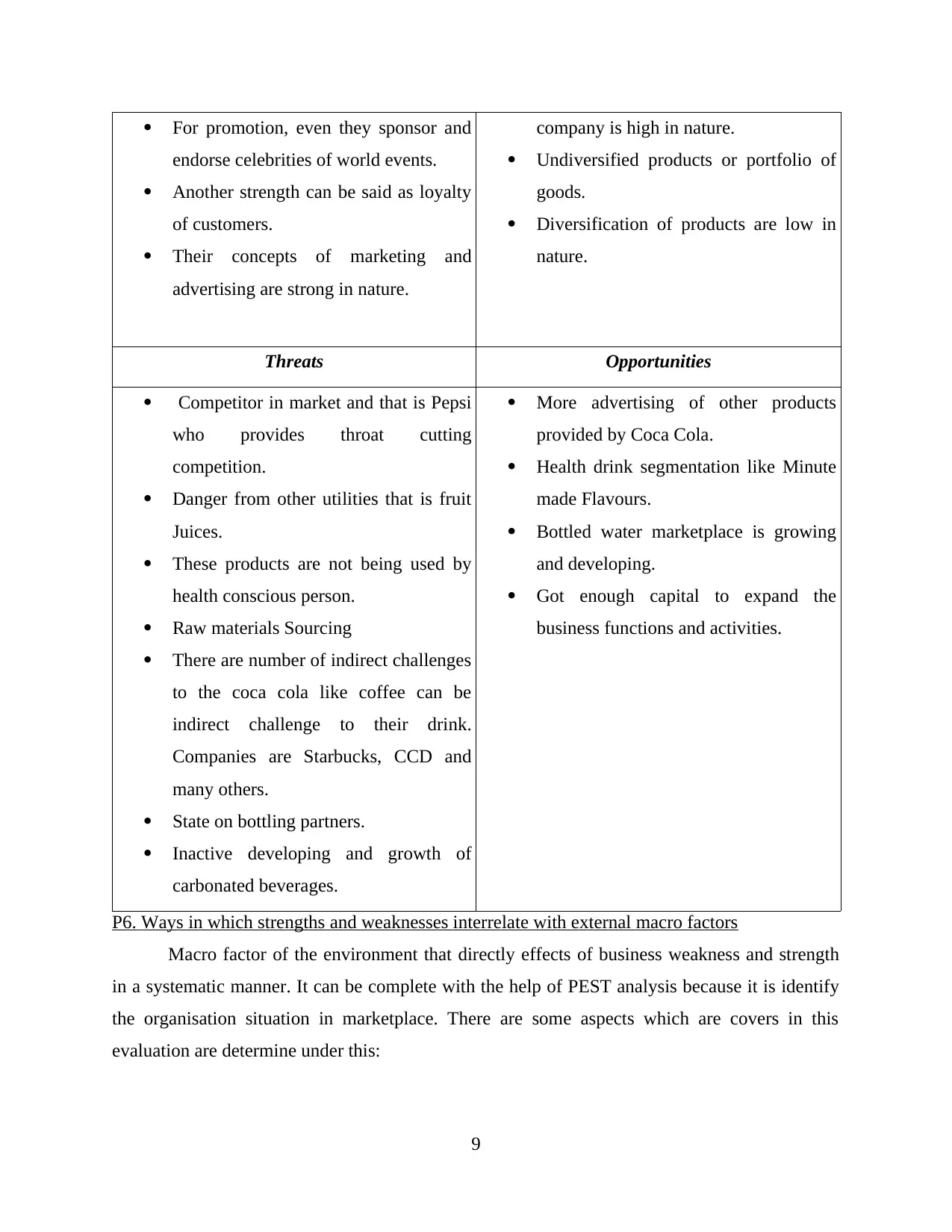
For promotion, even they sponsor and
endorse celebrities of world events.
Another strength can be said as loyalty
of customers.
Their concepts of marketing and
advertising are strong in nature.
company is high in nature.
Undiversified products or portfolio of
goods.
Diversification of products are low in
nature.
Threats Opportunities
Competitor in market and that is Pepsi
who provides throat cutting
competition.
Danger from other utilities that is fruit
Juices.
These products are not being used by
health conscious person.
Raw materials Sourcing
There are number of indirect challenges
to the coca cola like coffee can be
indirect challenge to their drink.
Companies are Starbucks, CCD and
many others.
State on bottling partners.
Inactive developing and growth of
carbonated beverages.
More advertising of other products
provided by Coca Cola.
Health drink segmentation like Minute
made Flavours.
Bottled water marketplace is growing
and developing.
Got enough capital to expand the
business functions and activities.
P6. Ways in which strengths and weaknesses interrelate with external macro factors
Macro factor of the environment that directly effects of business weakness and strength
in a systematic manner. It can be complete with the help of PEST analysis because it is identify
the organisation situation in marketplace. There are some aspects which are covers in this
evaluation are determine under this:
9
endorse celebrities of world events.
Another strength can be said as loyalty
of customers.
Their concepts of marketing and
advertising are strong in nature.
company is high in nature.
Undiversified products or portfolio of
goods.
Diversification of products are low in
nature.
Threats Opportunities
Competitor in market and that is Pepsi
who provides throat cutting
competition.
Danger from other utilities that is fruit
Juices.
These products are not being used by
health conscious person.
Raw materials Sourcing
There are number of indirect challenges
to the coca cola like coffee can be
indirect challenge to their drink.
Companies are Starbucks, CCD and
many others.
State on bottling partners.
Inactive developing and growth of
carbonated beverages.
More advertising of other products
provided by Coca Cola.
Health drink segmentation like Minute
made Flavours.
Bottled water marketplace is growing
and developing.
Got enough capital to expand the
business functions and activities.
P6. Ways in which strengths and weaknesses interrelate with external macro factors
Macro factor of the environment that directly effects of business weakness and strength
in a systematic manner. It can be complete with the help of PEST analysis because it is identify
the organisation situation in marketplace. There are some aspects which are covers in this
evaluation are determine under this:
9
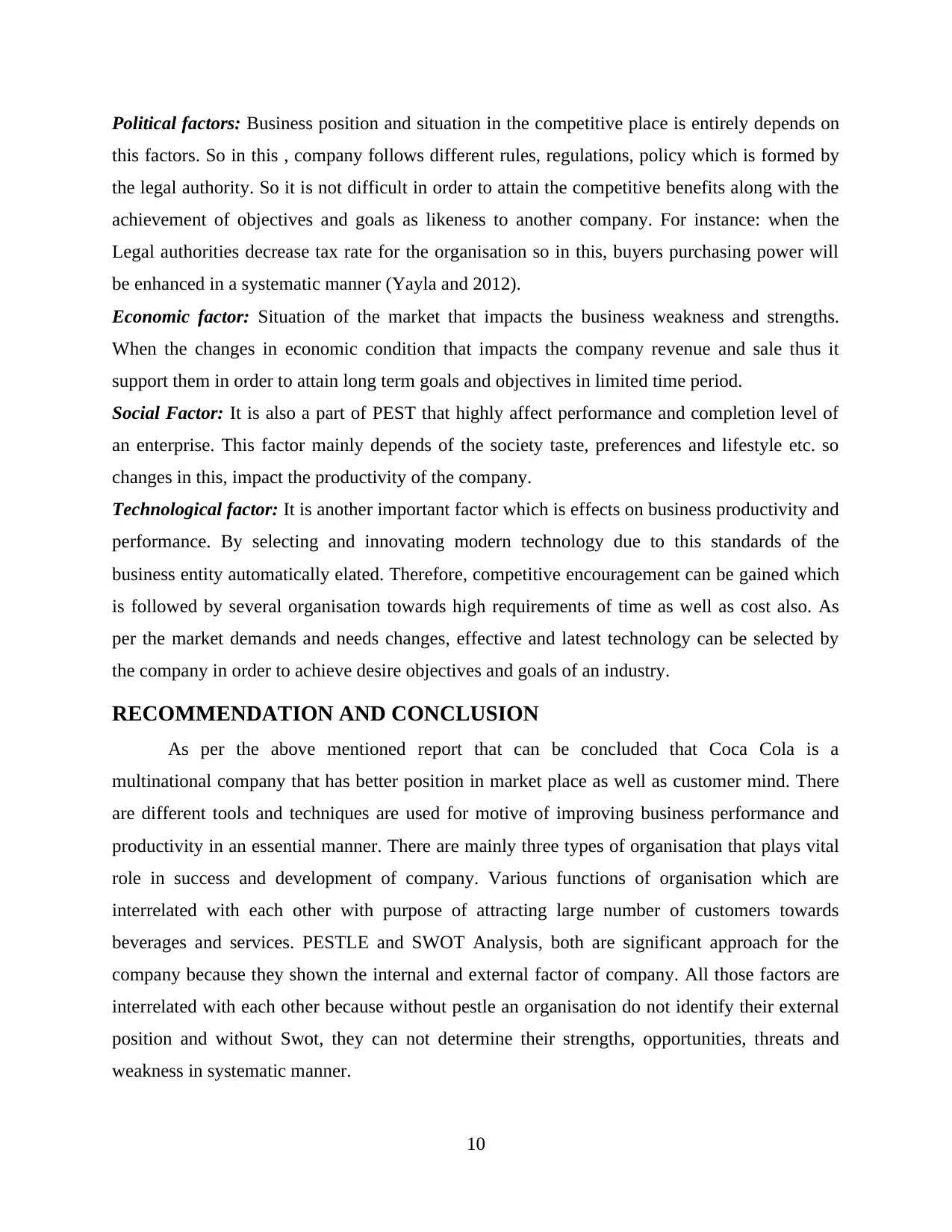
Political factors: Business position and situation in the competitive place is entirely depends on
this factors. So in this , company follows different rules, regulations, policy which is formed by
the legal authority. So it is not difficult in order to attain the competitive benefits along with the
achievement of objectives and goals as likeness to another company. For instance: when the
Legal authorities decrease tax rate for the organisation so in this, buyers purchasing power will
be enhanced in a systematic manner (Yayla and 2012).
Economic factor: Situation of the market that impacts the business weakness and strengths.
When the changes in economic condition that impacts the company revenue and sale thus it
support them in order to attain long term goals and objectives in limited time period.
Social Factor: It is also a part of PEST that highly affect performance and completion level of
an enterprise. This factor mainly depends of the society taste, preferences and lifestyle etc. so
changes in this, impact the productivity of the company.
Technological factor: It is another important factor which is effects on business productivity and
performance. By selecting and innovating modern technology due to this standards of the
business entity automatically elated. Therefore, competitive encouragement can be gained which
is followed by several organisation towards high requirements of time as well as cost also. As
per the market demands and needs changes, effective and latest technology can be selected by
the company in order to achieve desire objectives and goals of an industry.
RECOMMENDATION AND CONCLUSION
As per the above mentioned report that can be concluded that Coca Cola is a
multinational company that has better position in market place as well as customer mind. There
are different tools and techniques are used for motive of improving business performance and
productivity in an essential manner. There are mainly three types of organisation that plays vital
role in success and development of company. Various functions of organisation which are
interrelated with each other with purpose of attracting large number of customers towards
beverages and services. PESTLE and SWOT Analysis, both are significant approach for the
company because they shown the internal and external factor of company. All those factors are
interrelated with each other because without pestle an organisation do not identify their external
position and without Swot, they can not determine their strengths, opportunities, threats and
weakness in systematic manner.
10
this factors. So in this , company follows different rules, regulations, policy which is formed by
the legal authority. So it is not difficult in order to attain the competitive benefits along with the
achievement of objectives and goals as likeness to another company. For instance: when the
Legal authorities decrease tax rate for the organisation so in this, buyers purchasing power will
be enhanced in a systematic manner (Yayla and 2012).
Economic factor: Situation of the market that impacts the business weakness and strengths.
When the changes in economic condition that impacts the company revenue and sale thus it
support them in order to attain long term goals and objectives in limited time period.
Social Factor: It is also a part of PEST that highly affect performance and completion level of
an enterprise. This factor mainly depends of the society taste, preferences and lifestyle etc. so
changes in this, impact the productivity of the company.
Technological factor: It is another important factor which is effects on business productivity and
performance. By selecting and innovating modern technology due to this standards of the
business entity automatically elated. Therefore, competitive encouragement can be gained which
is followed by several organisation towards high requirements of time as well as cost also. As
per the market demands and needs changes, effective and latest technology can be selected by
the company in order to achieve desire objectives and goals of an industry.
RECOMMENDATION AND CONCLUSION
As per the above mentioned report that can be concluded that Coca Cola is a
multinational company that has better position in market place as well as customer mind. There
are different tools and techniques are used for motive of improving business performance and
productivity in an essential manner. There are mainly three types of organisation that plays vital
role in success and development of company. Various functions of organisation which are
interrelated with each other with purpose of attracting large number of customers towards
beverages and services. PESTLE and SWOT Analysis, both are significant approach for the
company because they shown the internal and external factor of company. All those factors are
interrelated with each other because without pestle an organisation do not identify their external
position and without Swot, they can not determine their strengths, opportunities, threats and
weakness in systematic manner.
10
⊘ This is a preview!⊘
Do you want full access?
Subscribe today to unlock all pages.

Trusted by 1+ million students worldwide
1 out of 14
Related Documents
Your All-in-One AI-Powered Toolkit for Academic Success.
+13062052269
info@desklib.com
Available 24*7 on WhatsApp / Email
![[object Object]](/_next/static/media/star-bottom.7253800d.svg)
Unlock your academic potential
Copyright © 2020–2025 A2Z Services. All Rights Reserved. Developed and managed by ZUCOL.





